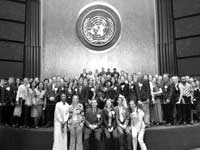

Finding
Agreement Without Conflict:
2300 Students at UNA-USA’s
Model U.N. Conference (Part I)
by Dorothy Davis
Saudi
Arabia’s ambassador
to the U. N., impeccably dressed in a dark suit and tie,
was surprisingly frank when asked his opinion. “Change
is important.” He regarded his interviewer with
the clear, confident gaze typical of royalty. “Saudi
Arabia must recognize the fact that we’re becoming
too one-sided. We focus too much on oil, ignoring the
fact that 70 percent of our poor people live in rural
areas, and this leads to social unrest. We should be
more balanced in our views.” Politely excusing
himself, the youthful ambassador dashed off with his
advisors and fellow delegates to a Security Council meeting.
The
sandy-haired, athletic looking ambassador from Qatar
also spoke with impressive self-assurance. “Qatar is trying to change its
political system from a monarchy to a constitutional
monarchy,” he said. When asked if his view of the
U. N. had altered during the months since his ambassadorial
appointment he said, “I look at the U. N. from
a different perspective. Before I thought it was this
thing controlled by the U. S., and now I see that it’s
all these countries talking about political issues and
figuring out ways to resolve their problems.”
Three
young lady ambassadors from France, beautifully attired
in their flowing traditional Muslim dresses, had also
learned some things. “Our views [about the U.
N.] have opened up a lot,” said one, as the others
nodded, “We know exactly more of what they do.” Then
they hurried off to the General Assembly to discuss
narcotic drugs and to the Security Council to discuss
its future.
Saudi
Arabia’s ambassador
actually came from Off-Site Educational Services, Outreach
House 1, in Ridgewood, Queens; Qatar’s ambassador
from Darien High School in Connecticut; France’s
ambassadors from Al-Ghazaly High School in Teaneck, New
Jersey.
They
were among the more than 2,300 middle and high school
students from 135 public and private schools in New
York City, fourteen other states and five countries
who attended the 5th Annual United Nations Association
of the United States of America Model United Nations
in New York City, an event sponsored by the Global
Classrooms program of the UNA-USA. It was held at the
Jacob Javits Center and at U. N. Headquarters recently.
All of the students had prepared for this “big
event” for months, either after school or in classes
during the day. They had researched their assigned country,
and studied diplomatic skills such as public speaking,
leadership, negotiation, higher order thinking, consensus
building, rules of order and problem solving.
The UNA-USA Model U. N. Conference,
though a simulation, is real world, hands on and exciting.
The problems discussed, in the fields of peacekeeping,
sustainable development and human rights, are on the
current U. N. agenda.
At
a General Assembly session on torture, for example,
visited during a tour led by Brigette Iarrusso, Project
Manager of Global Classrooms, New York City, three
ambassadors gave brief speeches. They did so only after
waving their white placards in hopes of being chosen
by the chairperson from a sea of similarly waving white
placards.
The
ambassador from Pakistan (from Brooklyn Technical High
School) said, “Torture
is one of the worst violations of human rights. Pakistan
denounces it. Due to conflict between Pakistan and India
over Kashmir, people of Kashmir are victims of torture.” She
called for a referendum among its citizens as the only
remedy.
The
Croatian ambassador (from Long Island City High School)
said, “Starting in 1984 following the death of
Yugoslavian President Tito, Serbia and Croatia have
been at war. Torture is not an everyday war tactic,
but a crime against humanity. Croatia does not accept
torture for any reasons, whether for national security
or any other.”
The
ambassador from the Dominican Republic (from ASHS at
Bronx Regional) said, “Our people have suffered
the fate of torture under the Trujillo regime. Thousands
were victims. Later under Duarte our people were victims
again, tortured until they renounced their revolutionary
ideals.”
The meeting then voted in favor
of a motion on the floor calling for five minutes of
un-moderated caucus. The delegates met in informal groups
and held spirited discussions on draft resolutions and
other issues.
The
goal of each two-day meeting, Iarrusso said, is to
hammer out one or two resolutions, which are approved
by voting. These are solutions to the global problems
discussed. They are posted on the UNA-USA website (www.unausamun.org)
and presented to the United Nations itself. Ambassador
Stuart W. Holliday, the Ambassador and Alternate United
States Representative to the United Nations, in his
remarks at the opening ceremony, encouraged the student
ambassadors to pursue a career in public service. He
also said, referring to the dire need for humanitarian
aid in Sudan, “An
issue has to have support. You can make a difference
to these people. They are depending on you.” Through
their published resolutions, the Model U. N. ambassadors
can make a difference in the world.
Although
Model UN has been around since 1945 it was only after
Ambassador William H. Luers became President of UNA-USA
in 1999 that it grew from an extra-curricular activity
for mainly private schools to being part of the curriculum
for urban public schools, especially those in the inner
city. After he and his board concluded that education
was their most important project, Amb. Luers appointed
Dr. Lucia Rodriguez as Vice President for Education,
and under her guidance, the Global Classrooms program
was begun.
Teachers at the conference
werej enthusiastic about the Global Classrooms program.#
July issue: Part II.
